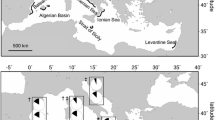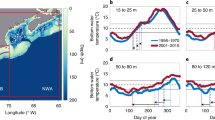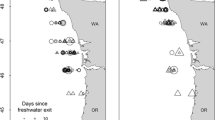Abstract
Although long-distance transport of marine organisms is constrained by numerous oceanic and biological factors, some species have evolved life-histories reliant on such movements. We examine the factors that promote long-distance transport in a transoceanic migrant, young loggerhead sea turtles (Caretta caretta), from the southeastern U.S. Empirical data from near-surface buoys and simulations in two ocean circulation models indicated that passive drifters are often retained for long periods shoreward of oceanic fronts that delineate coastal and offshore waters. Further simulations revealed that offshore swimming aided newly hatched turtles in moving past fronts and increased turtles’ probability of survival, reaching distant foraging grounds, and encountering favorable temperatures. Swimming was most beneficial in regions that were more favorable under scenarios assuming passive drift. These results have broad implications for understanding the movement processes of many marine species, highlighting likely retention of more planktonic species and potential for dispersal in more nektonic species.



Similar content being viewed by others
References
Aretxabaleta A, Nelson JR, Blanton JO, Seim HE, Werner FE, Bane JM, Weisberg R (2006) Cold event in the South Atlantic Bight during summer of 2003: anomalous hydrographic and atmospheric conditions. Marine Sci Fac Publ Paper 133:17
Azumaya T, Ishida Y (2004) An evaluation of the potential influences of SST and currents on the oceanic migration of juvenile and immature chum salmon (Oncorhynchus keta) by a simulation model. Fish Oceanogr 13:10–23
Bane JM, Dewar WK (1988) Gulf Stream bimodality and variability downstream of the Charleston Bump. J Geophys Res 93:6695–6710
Belkin IM, Cornillon PC, Sherman K (2009) Fronts in large marine ecosystems. Prog Oceanogr 81:223–236
Bleck R (2002) An oceanic general circulation model framed in hybrid isopycnic cartesian coordinates. Ocean Model 4:55–88
Blumenthal JM, Abreu-Grobois FA, Austin TJ, Broderick AC, Bruford MW, Coyne MS, Ebanks-Petrie G, Formia A, Meylan PA, Meylan AB, Godley BJ (2009) Turtle groups or turtle soup: dispersal patterns of hawksbill turtles in the Caribbean. Mol Ecol 18:4841–4853
Bowen BW, Abreu-Grobois FA, Balazs GH, Kamezaki N, Limpus CJ, Ferl RJ (1995) Trans-Pacific migrations of the loggerhead sea turtle demonstrated with mitochondrial DNA markers. Proc Natl Acad Sci USA 92:3731–3734
Boyle MC, FitzSimmons NN, Limpus CJ, Kelez S, Velez-Zuazo X, Waycott M (2009) Evidence for transoceanic migrations by loggerhead sea turtles in the southern Pacific Ocean. Proc Royal Soc B 276:1993–1999
Carr AF (1987) New perspectives on the pelagic stage of sea turtle development. Conserv Biol 1:103–121
Chassignet EP, Hurlburt HE, Smedstad OM, Halliwell GR, Hogan PJ, Wallcraft AJ, Baraille R, Bleck R (2007) The HYCOM (HYbrind Coordinate Ocean Model) data assimilative system. J Mar Syst 65:60–83
Clarke J, Kerry K, Fowler C, Lawless R, Eberhard S, Murphy R (2003) Post-fledgling and winter migration of Adélie penguins Pygoscelis adeliae in the Mawson region of East Antarctica. Mar Ecol Prog Ser 248:267–278
Collard SB, Ogren LH (1990) Dispersal scenarios for pelagic post-hatchling sea turtles. Bull Mar Sci 47:233–243
Cowen RK, Sponaugle S (2009) Larval dispersal and marine population connectivity. Ann Rev Marine Sci 1:443–466
Cowen RK, Paris CB, Srinivasan A (2006) Scales of connectivity in marine populations. Science 311:522–527
Davenport J (1997) Temperature and the life-history strategies of sea turtles. J Therm Biol 22:479–488
Edwards KP, Hare JA, Werner FE, Blanton BO (2006) Lagrangian circulation on the southeast US Continental Shelf: implications for larval dispersal and retention. Cont Shelf Res 26:1375–1394
Hare JA, Walsh HJ (2007) Planktonic linkages among marine protected areas on the south Florida and southeast United States continental shelves. Can J Fish Aquat Sci 64:1234–1247
Hare JA, Churchill JH, Cowen RK, Berger TJ, Cornillon PC, Dragos P, Glenn SM, Govoni JJ, Lee TN (2002) Routes and rates of larval fish transport from the southeast to the northeast United States continental shelf. Limnol Oceanogr 47:1774–1789
Hays GC, Fossette S, Kastelidis KA, Mariani P, Schofield G (2010) Ontogenetic development of migration: lagrangian drift trajectories suggest a new paradigm for sea turtles. J R Soc Interface 7:1319–1327
He R, Weisberg RH (2002) Tides on the west Florida shelf. J Phys Oceanogr 32:3455–3473
He R, Weisberg RH (2003) A Loop Current intrusion case study on the west Florida Shelf. J Phys Oceanogr 33:465–477
Hill AE (1991) A mechanism for horizontal zooplankton transport by vertical migration in tidal currents. Mar Biol 111:485–492
Hyun KH, He R (2010) Coastal upwelling in the South Atlantic Bight: a revisit of the 2003 cold event using long term observations and model hindcast solutions. J Mar Syst 83:1–13
Kraemer JE, Bennett SH (1981) Utilization of posthatchling yolk in loggerhead sea turtles (Caretta caretta). Copeia 1981:406–411
Largier J (2003) Considerations in estimating larval dispersal distances from oceanographic data. Ecol Appl 13:S71–S89
Lett C, Verley P, Mullon P, Parada C, Brochier T, Penven P, Blanke B (2008) A Lagrangian tool for modelling ichthyoplankton dynamics. Environ Model Softw 23:1210–1214
Lohmann KJ, Lohmann CMF (2003) Orientation mechanisms in hatchling sea turtles. In: Bolten AB, Witherington BE (eds) Loggerhead sea turtles. Smithsonian Institution Press, Washington
Luiz OJ, Madin JS, Robertson DR, Rocha LA, Wirtz P, Floeter SR (2011) Ecological traits influencing range expansion across large oceanic dispersal barriers: insights from tropical Atlantic reef fishes. Proc Royal Soc B 279:1033–1040
Madec G (2008) “NEMO ocean engine”. Note du Pole de modélisation, Institut Pierre-Simon Laplace (IPSL), France, No 27 ISSN No 1288–1619
Mansfield KL, Saba VS, Keinath J, Musick JA (2009) Satellite telemetry reveals a dichotomy in migration strategies among juvenile loggerhead sea turtles in the northwest Atlantic. Mar Biol 156:2555–2570
Nathan R, Getz WM, Revilla E, Holyoak M, Kadmon R, Saltz D, Smouse PE (2008) A movement ecology paradigm for unifying organismal movement research. Proc Natl Acad Sci USA 105:19052–19059
O’Hara J (1980) Thermal influences on the swimming speed of loggerhead turtle hatchlings. Copeia 1980:773–780
Ohlmann JC, Niiler PP (2005) Circulation over the continental shelf in the northern Gulf of Mexico. Prog Oceanogr 64:45–81
Putman NF, Bane JM, Lohmann KJ (2010a) Sea turtle nesting distributions and oceanographic constraints on hatchling migration. Proc Royal Soc B 277:3631–3637
Putman NF, Shay TJ, Lohmann KJ (2010b) Is the geographic distribution of nesting in the Kemp’s ridley turtle shaped by the migratory needs of offspring? Integr Comp Biol 50:305–314
Putman NF, Verley P, Shay TJ, Lohmann KJ (2012) Simulating transoceanic migrations of young loggerhead sea turtles: merging magnetic navigation behavior with an ocean circulation model. J Exp Biol 215:1863–1870
Salmon M, Wyneken J (1987) Orientation and swimming behavior of hatchling loggerhead turtles Caretta caretta L. during their offshore migration. J Exp Mar Biol Ecol 109:137–153
Savidge DK, Bane JM (2001) Wind and Gulf Stream influences on along-shelf transport and off-shelf export at Cape Hatteras, North Carolina. J Geophys Res 106:505–527
Scott R, Marsh R, Hays GC (2012) A little movement orientated to the geomagnetic field makes a big difference in strong flows. Mar Biol 59:481–488
Shillinger GL, Di Lorenzo E, Luo H, Bograd SJ, Hazen EL, Bailey H, Spotilla JR (2012) On the dispersal of leatherback turtle hatchlings from Mesoamerican nesting beaches. Proc Royal Soc B 279:2391–2395
Sponaugle S, Lee T, Kourafalou V, Pinkard D (2005) Florida current frontal eddies and the settlement of coral reef fishes. Limnol Oceanogr 50:1033–1048
Staaterman E, Paris CB, Helgers J (2012) Orientation behavior in fish larvae: a missing piece to Hjort’s critical period hypothesis. J Theor Biol 304:188–196
Tester PA, Steidinger KA (1997) Gymnodinum breve red tide blooms: initiation, transport and consequences of surface circulation. Limnol Oceanogr 42:1039–1051
Whelan CI, Wyneken J (2007) Estimating predation levels and site-specific survival of hatchling loggerhead sea turtles (Caretta caretta) from south Florida beaches. Copeia 2007:745–754
Witherington BE (1991) Orientation of hatchling loggerhead turtles at sea off artificially lighted and dark beaches. J Exp Mar Biol Ecol 149:1–11
Witherington BE (2002) Ecology of neonate loggerhead turtles inhabiting lines of downwelling near a Gulf Stream front. Mar Biol 140:843–853
Wyneken J, Salmo M (1992) Frenzy and postfrenzy activity in loggerhead, green, and leatherback hatchling sea turtles. Copeia 1992:478–484
Wyneken J, Madrak SV, Salmon M, Foote J (2008) Migratory activity by hatchling loggerhead sea turtles (Caretta caretta L.): evidence for divergence between nesting groups. Mar Biol 156:171–178
Yang H, Weisberg RH, Niiler PP, Sturges W, Johnson W (1999) Lagrangian circulation and forbidden zone on the West Florida Shelf. Cont Shelf Res 19:1221–1244
Acknowledgments
NFP, GCH, and RS conceived the project. PV developed ICHTHYOP software, NFP ran the HYCOM simulations, and RS and RM calculated the NEMO trajectories. NFP and RS analyzed the data, NFP wrote the manuscript with contributions from all authors. NFP was supported by NCSU’s Initiative for Biological Complexity and a Journal of Experimental Biology travel fellowship. RS was funded through a PhD studentship awarded to GCH from the Natural Environment Research Council. GCH was supported by grants from the Natural Environmental Research Council, The Esmée Fairbairn Foundation and the Climate Change Consortium for Wales (C3W).
Author information
Authors and Affiliations
Corresponding author
Additional information
Communicated by R. Lewison.
Rights and permissions
About this article
Cite this article
Putman, N.F., Scott, R., Verley, P. et al. Natal site and offshore swimming influence fitness and long-distance ocean transport in young sea turtles. Mar Biol 159, 2117–2126 (2012). https://doi.org/10.1007/s00227-012-1995-5
Received:
Accepted:
Published:
Issue Date:
DOI: https://doi.org/10.1007/s00227-012-1995-5




